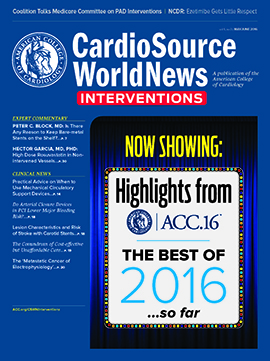From the Editor: Meet the Editor | Peter C. Block, MD Editor-in-Chief, CardioSource WorldNews: Interventions
CardioSource WorldNews Interventions | CardioSource WorldNews: Interventions is excited to announce the newest member to our team: Peter C. Block, MD, FACC. In this interview, Dr. Block shares his thoughts on interventional cardiology and what he hopes CSI readers can anticipate moving forward.
What is your background as an interventional cardiologist, and what drew you to this specialty?
I had just taken over as chief of the catheterization laboratory at the Massachusetts General Hospital (MGH), Boston, MA, when, in early 1976, Andreas R. Grüntzig, MD, visited. He was doing balloon angioplasty in femoral arteries, and we talked about the possibilities of doing the same in the coronary circulation. After he did his first coronary case in Sept. 1977, only about six or seven “catheterizers” (there were no “interventionalists”) here and in Europe began to look for appropriate patients. The first MGH case was done in June 1978. It was an exciting time—those who believed in the technique and did their first cases called one another after nearly every case to compare thoughts and experiences. We all met in Zurich, Switzerland, that summer to tally up the total case numbers and our outcomes. I remember that nearly one in four patients was taken urgently to the operating room for coronary artery bypass graft surgery! The complications made for a lot of skeptical coronary surgeons, but the successes were amazing. Shortly before that meeting in Zurich, an unconvinced surgical colleague of mine challenged me to show how angioplasty “worked.” That challenge sent me to the animal lab and to post-mortem studies that helped reveal the mechanism of angioplasty, and it began my academic career in cardiology.
Then, in 1979, the handful of coronary angioplasty operators who were doing cases around the world met at the National Institutes of Health to start the National Heart, Lung, and Blood Institute Percutaneous Transluminal Coronary Angioplasty (NHLBI PTCA) Registry, which established the first database for PCI and helped expand the use of the technique. With better technology and experience, complications were reduced. Balloon aortic and mitral valvuloplasty followed in the early 1980’s, along with transcatheter atrial and ventricular septal closure, and this new field captured my interest.
Coronary angioplasty had become mainstream by then (remember it was all “plain old balloon angioplasty” as stents were not developed till the early 1990’s) and the emerging technologies that allowed transcatheter treatment of mitral and aortic stenosis were simply too intriguing to ignore. We, at the MGH in conjunction with colleagues at the Beth Israel Hospital in Boston, MA, hosted the first demonstration course in valvuloplasty in Boston in 1986, which followed the live case format that Grüntzig introduced for coronary work. The course featured Alain Cribier, MD, from France (who championed balloon aortic valvuloplasty) and also the cardiac valve surgeons and their medical colleagues who had collaborated to perform the first breakthrough surgical valve procedures in the 1950’s. That unique meeting kick-started widespread understanding that there had to be collaboration between surgeons, imagers, and interventionalists in order to best care for patients with valve disease. Now, 30 years later, we have “Heart Teams” that oversee structural heart disease intervention. It has been quite a journey.
For you, what are the key issues facing interventional cardiologists today?
If I had to pick two words, they would be “justification” and “quality.” It is not news that all of us in interventional cardiology have been under the microscope for the past years. We are “low-hanging fruit,” and the volume of our work impacts the cost of health care. The field of interventional cardiology has expanded so quickly that oversight bodies, such as Cardiology Medicaid Services and, ultimately, the Office of the Inspector General, are now focused on us all.
The issue of appropriateness in interventions constantly reminds us that we need to be as certain as we can that what we do is not only appropriate, but also reflects quality care. Though sometimes it appears onerous, taking the extra time to evaluate an intervention more closely (think fractional flow reserve or Intravascular ultrasound for coronary interventions) goes a long way to justify actually doing something. That also becomes a “quality” metric. When I look at interventional clinical trials I am struck by how many are simply asking questions of appropriateness of procedures for certain subsets of patients.
The currently enrolling COAPT Trial in the U.S. is a good example of interrogating appropriateness. The trial’s results, hopefully, will answer the question: “Should we or should we not try to improve mitral regurgitation in patients with functional mitral regurgitation by doing a transcatheter intervention with the MitraClip®?” We know we can reduce mitral regurgitation in many patients, but does that equate to improved clinical outcomes? We will see. That is just one example. I am certain that oversight of what we do will increase. Reimbursements are increasingly being attached to quality metrics, even in our subspecialty. Our challenge is to help make the metrics that are chosen to judge us relevant as well as user friendly to us and to our patients and their outcomes.

|
Read the full May/June issue of CardioSource WorldNews Interventions at ACC.org/CSWNI |
Keywords: CardioSource WorldNews Interventions, Percutaneous Coronary Intervention, Intervention Studies
< Back to Listings
